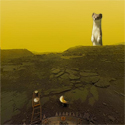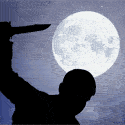|
polyfractal posted:Holy crap I took pictures of stars! If they were star trails from an absence of tracking they would all trail in the same direction. The distortion at the corners is likely an optical abberation caused by the lens design. That's not necessarily indicative of a poor quality lens either, some distortion can be the product of design tradeoffs. It could also be that the image is not formed on a perfectly flat plane. At any rate all you might be stuck either cropping the image to minimize the distortion or use another lens if you want to minimize it. Alternatively you might have some bad frames. You could stacking fewer of the best frames and sees if it cleans it up. Page Downfall fucked around with this message at 15:41 on Nov 25, 2013 |
|
|
|

|
| # ? May 30, 2024 16:22 |
|
Venusian Weasel posted:Looks like Aries to me. Awesome  Page Downfall posted:If they were star trails from an absence of tracking they would all trail in the same direction. The distortion at the corners is likely an optical abberation caused by the lens design. That's not necessarily indicative of a poor quality lens either, some distortion can be the product of design tradeoffs. It could also be that the image is not formed on a perfectly flat plane. At any rate all you might be stuck either cropping the image to minimize the distortion or use another lens if you want to minimize it. Do people do lens corrections in astrophotography? I know for general photography in Lightroom, it is pretty common to correct lens distortion. Does that mess up astrophotography though, since the exposures are so much longer? In other news, I took advantage of the clear night and tried the Pleiades. Definitely getting real star trails in this one, the stars are overexposed and the noise is kinda crappy. I think it is largely just my inexperience with Pixinsight...and perhaps needing some more light frames to mash the noise down a bit more (and shorter exposure for star trails, obviously). Last "bad" image for a while, going to try and get a really clean image whenever I post next  
|
|
|
|
Phil Plait just posted that ISON may have broken up. I'm going to be bummed if I missed my chance to see it. http://www.slate.com/blogs/bad_astronomy/2013/11/25/comet_ison_sudden_drop_in_ice_output.html
|
|
|
|
Yeah, it's not looking very good. Kind of disappointed, but still hopeful that it'll survive. I wanna see a good comet, dammit! Now that I've got a handle on DSS, I've started working on some of the other pictures I'd taken this month. Comet Lovejoy passing the Beehive:  Lovejoy 11-7 small by venusian-weasel, on Flickr Venusian Weasel fucked around with this message at 06:45 on Nov 26, 2013 |
|
|
|
So first, a little background: I've got a Bushnell Voyager 900mmx4.5" (near as I can tell) reflector from probably the mid to late 90s. It was a Christmas gift from my parents a long time ago. The original eyepieces were lost ages ago so a few years back I picked up that box set of Celestron lenses + filters and it's worked out well so far. I've been using it on and off to varying degrees of success. I guess I can't really tell if the telescope is much good or not. I know it works well for casual stargazing and the moon/planets, but it's not fantastic or anything. The biggest problem with the telescope so far is that the mount is garbage. If you even look at it funny it wobbles uncontrollably. I'm planning on hacking together an electric motor to control the focus. One of the problems I have is that when trying to focus, I can't tell if something is in focus or not because the drat thing wobbles so much. Then, if that works, I was going to try to build a tracking motor for the RA, which is obviously a bit more involved since I'll need some sort of speed control, but I'm sure I can manage. At the least I'd like to have a motor control so I can keep things lined up without causing the thing to wobble. So first, is this worth keeping around for a while yet? I would like to get in to photography eventually, but the first thing I need there is a camera, so the telescope isn't really a limiting factor yet. I mostly want to keep doing some casual observing. And also, I'm wondering if it's worthwhile to get a solar filter for this thing. I took an astronomy class in high school and the teacher took us out to look at the sun. I thought it was pretty cool and I'd like to do it again, especially with the solar maximum going on. I've done some basic searching and I've found some options for around $75? Is that a good price? I haven't done enough research to know if that's crazy expensive and high quality, or if it's dirt cheap garbage, since this is kind of a niche application.
|
|
|
|
Usually if the mount is garbage, the telescope is too. Sounds like a cheap department store telescope to me. If you've got the money, just upgrade to a 6-8" dob. Orion has a decent series of entry-level go-to dobsonian scopes. Solar filters are cool, but unless you want to look at sunspots on a regular basis, probably not worth it. If you don't have to worry about kids getting around the scope, it's easier just to project the image on a piece of paper a foot or two away and look at the sun on that. If you really want one though, the mylar ones do the job. Venusian Weasel fucked around with this message at 00:26 on Nov 27, 2013 |
|
|
|
I don't know what your mount looks like but sometimes a super simple thing you can try would be sticking some solid rubber feet, like chair feet or similar on the ends of the legs. Can add a little stability and damp any vibrations coming through the ground, especially if you observe on a hard surface. Probably won't save your mount but it's dirt cheap to try.
|
|
|
|
I'm pretty sure it is a cheap department store telescope, but so far it's been OK for viewing the moon and the planets. I'm trying to find a way to make it more useful as-is. The long term plan is to upgrade to something better when I have some spare cash lying around, but for the time being this is what I have to work with. The tripod already has rubber feet on it, so there's not much I can do there. Well, I could probably get something a little thicker, but as it is the main problem is when I try to make adjustments to it. For what I'm doing, ground vibrations aren't significant. Are you sure about projecting the sun on to something through the telescope? That seems like a good way to start something on fire. In other news, spaceweather.com is reporting that ISON is still intact despite the reports from a day or two ago. I wasn't able to get a glimpse of it, despite getting up at the asscrack of dawn to try to spot it. I also just realized that I'm going to be stuck in Detroit for the first 2 weeks of December, so here's to hoping the best is yet to come (and not until I get back home on Dec 13). Though from all accounts, if it survives perihelion then it should be visible to varying degrees in to January.
|
|
|
|
My equatorial mount used to wobble like crazy, so I put some dumbbell weights in the tray and that stabilized it pretty well. It also varies depending on where you're standing. If you're on wooden decking you'll have more wobble than if you're in the middle of a field.
|
|
|
|
If the tripod has split hollow aluminium legs you can fill them with sand or expanding foam filler, something to add weight and rigidity. The modern tripods have nice tubular steel leg tripods which are far more stable. But yeah, add weight and stability, tighten everything up.
|
|
|
|
What's a safe (for the CCD) way to get a shot of ISON tomorrow, assuming it hits mag -5 or so as predicted? My Nikon 5200 has an articulating screen so I should be able to live view it up and not look at the sun directly but I don't want to fry the chip.
|
|
|
|
Eegah posted:What's a safe (for the CCD) way to get a shot of ISON tomorrow, assuming it hits mag -5 or so as predicted? My Nikon 5200 has an articulating screen so I should be able to live view it up and not look at the sun directly but I don't want to fry the chip. My plan is to hide the sun just behind an object, and then take pics. Not sure it's gonna be visible at all, it's right on the borderline. Clear skies are going to be a must.
|
|
|
|
Not looking good for ISON... https://twitter.com/esa/status/406173496662695936 quote:Our #SOHO scientists have confirmed, comet #IISON is gone , thanks for sharing this comet-watching night with us http://www.universetoday.com/106813/is-comet-ison-dead-astronomers-say-its-likely-after-icarus-sun-grazing-stunt/ http://www.slate.com/blogs/bad_astronomy/2013/11/28/ison_update_for_22_00_utc_nov_28.html
|
|
|
|
Boo-urns.
|
|
|
|
What a disappointing night! ISON burns up and SpaceX aborts their launch. I'm glad I have pecan pie leftovers to comfort myself with.
|
|
|
|
I've been drinking myself into a stupor to get over the pain of losing ISON.
|
|
|
|
AstroZamboni posted:I've been drinking myself into a stupor to get over the pain of losing ISON. I don't know, this sure looks like ISON survived:  This comet is weird.
|
|
|
|
Hi astronomy goons! I have a question I hope you can help me with. I have a very basic understanding of star charts, which can be summed up as "they depict the sky at a given latitude at a given time of the year, and if you hold one overhead and line it up then you can find things". Recently, I was at a friend of a friends and they had one of these hanging on the wall:  I never got the chance to ask, but I don't know what the deal is with the months around the outside or how you're supposed to read it. Is it purely decorative and not useful in any real sense, or is there a technique to making sense of it?
|
|
|
|
Xpost from the spaceflight thread where I answered your question:rolleyes posted:How the hell do you read that? I never got the chance to ask, but I don't know what the deal is with the months around the outside. Or is it purely artistic and not actually useful? If you guys aren't sure, is there an astronomy thread somewhere where I might be able to find out? First you figure out your declination. It's really easy, it's just your latitude. You find that number on the declination line and trace that around a concentric circle to the current month and day. That point will give you the zenith at midnight on the given day. As a rule of thumb, points 90 degrees away will be at the zenith at dusk and dawn, and points 90 degrees from those will be on the horizon at sunset. This chart on shows stars to the celestial equator, so the only place this chart shows all the stars visible is from the North Pole. At 45 degrees north it only shows two-thirds of the stars visible, and at the equator only half.
|
|
|
|
PREYING MANTITS posted:I don't know, this sure looks like ISON survived: The plucky little comet that could. 
|
|
|
|
Schroedinger's comet. Made of pure spite. Dead, then not dead. Dead, then not dead. MAKE UP YOUR loving MIND, YOU GODDAMN COCKTEASE.
|
|
|
|
ISON realized it was drunk and is going home.
|
|
|
|
Ultra-wide field shots, mostly as practice for PixInsight. Im amazed at what DynamicBackgroundExtraction can do...it sometimes feels like it is just making up stars and pasting them into the image. Crazy. It also makes it apparent why you need some landscape or horizon in widefield shots...with so many stars visible it just looks like noise. Feel like it needs a horizon to balance against the ridiculous starfield. Registered, integrated and a bit of tweaking in Lightroom:  DBE plus some attempts at noise removal and removing a bit of green tint:  Hints or tips welcome! I'm basically going off Harry's videos atm (thanks Jekub!), but it feels like those are more geared towards resolving and denoising large structures like galaxies and nebula, instead of wide star fields.
|
|
|
|
Venusian Weasel posted:Xpost from the spaceflight thread where I answered your question: Thanks for this - can you or anyone else tell me what the declination line is? I'd like to be able to figure out how to read this thing but without that I'm a bit lost and Google is still not helping me out, I guess I don't know the right keywords to get a relevant answer. edit: Ok I finally noticed the decloination line was staring me right in the face.  Please ignore this - new question below! If I'm getting this right, it looks like the producer (artist?) has already done what you described in that there is an arc passing through 70 degrees on the declination line - can you tell me which month/day that is for and how the radius of the arc is determined? rolleyes fucked around with this message at 14:36 on Dec 2, 2013 |
|
|
|
I'm about to buy my first telescope- after like 1000 hours of research it turns out a guy local to me is selling an Orion XT6 for $160, which seems like a great deal on a great first telescope. I live in Dallas TX, so I have tons of light pollution and basically want to see the moon and some planets and whatever else I can. I go camping maybe 4-5 times a year as well so will have some better shots at darker skies. What should I be wary of when buying a used telescope? My plan was basically to peer in with a flashlight and make sure the primary mirror is not cracked or anything and then make sure I can resolve a star or the moon sharply. And of course any obvious major dents/dings. I'm not sure how old it is, but I don't think the design has ever changed. It comes with 25 and 10 mm plossl eyepieces- I also grabbed a Orion shorty barlow for $23 on the black Friday sale. I figure that will set me up pretty good for now. Should I even bother with a telrad or anything when my light pollution is so crappy? Most nights I'm lucky to see 6 stars by eye total- maybe if I go to a nearby park it will be better.
|
|
|
|
Sorry to keep going on about the sky map, but I've managed to find some reference material at last so have tried to understand it. Some searching turned up a university's Intro to Astronomy course material, so I've read up on the terminology reference and information about sky maps and star finders. I'm still not entirely sure what the correct name for base image I posted is though - is it a sky map, a star finder or a cross between the two? Anyway, following Venusian Weasel's instructions, here's one I've tried to mark up for London on 2nd Dec:  Here is what I think I've annotated:
Can anyone tell me whether this is at least partially right? I'm also curious to know how I know where south, east and west are on this representation (presumably this ties in to getting the meridian correct), and roughly how I can tell which constellations are actually visible - I have a feeling this has to do with the elliptic but I'm not sure. rolleyes fucked around with this message at 14:41 on Dec 2, 2013 |
|
|
|
If you hold the map with the meridian pointing away from you, stuff on the left will be west, stuff on the right will be east. Polaris is always in the direction of north. Anyway, a picture of Comet Lovejoy from Thanksgiving! Total exposure time is just over 17 minutes. Took forever to take the individual 3" frames to make this.  Lovejoy 11-28 widefield by venusian-weasel, on Flickr If you look carefully you can see the Whirlpool Galaxy near the top.
|
|
|
|
Sorry this is low effort. I don't know the first thing about telescopes, but my dad wants one for Christmas. This is the one he picked out for himself: http://www.amazon.com/dp/B0007UQNNQ/ref=wl_it_dp_o_pC_S_ttl?_encoding=UTF8&colid=X47GHW3DRRWG&coliid=I3LJ0RGTCF596N Any thoughts on it? He wants to spend around $500, plus more on accessories.
|
|
|
|
USSMICHELLEBACHMAN posted:Sorry this is low effort. I don't know the first thing about telescopes, but my dad wants one for Christmas. This is the one he picked out for himself: That's the same OTA as the Orion Spaceprobe 130. Decent optics. A little on the heavy side for that mount (or more accurately the tripod. The mount head itself is sturdy enough), but a decent scope with a nice GOTO system.
|
|
|
|
So it looks like the Spaceprobe 130 is only $250 from Orion's site. If both scopes have the same optics, does that mean that with the Celestron he's essentially spending $250 for the tracking unit? It seems like it would be smarter to get something with a better OTA and no computer for $500, and then add a tracker later on.
|
|
|
|
USSMICHELLEBACHMAN posted:So it looks like the Spaceprobe 130 is only $250 from Orion's site. If both scopes have the same optics, does that mean that with the Celestron he's essentially spending $250 for the tracking unit? The spaceprobe 130 can't be retrofitted with a GOTO system unless you put the scope on a whole new mount. I suggest getting the Spaceprobe 130 and a good star atlas and learning the night sky, then eventually working up to a higher end goto scope if you stick with the hobby.
|
|
|
|
He has another cheap telescope that he's been using for years -- I think he's fairly serious about it. Do you have any recommendations between $400-500 for a scope with good optics that could be outfitted with a Goto somewhere down the line?
|
|
|
|
Almost any scope can be converted to GOTO just from buying a new mount with that capability, but it'll cost a lot when you choose to go that route. I think a much better non-computerized scope for the 500 bucks would be the Celestron Omni 102 XLT refractor. It's also more easily remounted than the Spaceprobe 130 because it has a Vixen standard mounting rail.
|
|
|
|
Great, thanks for the info. I'll run those options by him.
|
|
|
|
My Grandpa recently passed away, and I got the spotting scope he used for birdwatching. It's definitely clumsy to use for astronomy, but I was able to resolve stripes on Jupiter tonight, and it made me pretty giddy. Stuff it Ptolemy, Jupiter has moons!
|
|
|
|
Having received confirmation of my bonus for the year and permission from my wife I will be upgrading my mount at some point in April / May. I am now trying to decide between the Skywatcher EQ8 (£2500) or the iOptron CEM60 (£2100). Both are very new to the market, the EQ8 hold 50kg where the CEM60 holds 27kg. I like the design of the CEM60, it has a lot of nice features and still remains reasonable portable if I want to move it from the observatory though I think I will be keeping the CGEM for portable work so that may not be a big deal. The EQ8 seems to have a PE of under +/- 5 arc seconds and seems reasonably smooth from the tests I have seen, the CEM60 isn't out yet so there are no published results. Both support permanent PEC though. At least I have a few months to make a decision because right now I am completely torn. I keep looking at second hand as well but there really isn't anything comparable in that budget range over here.
|
|
|
|
Apart from the EQ8 having the edge in capacity and being a known quantity at this point, I would have some trepidation about being an early adopter on the CEM60. It's such a radically non-traditional design that I suspect it'll have a longer shakedown cruise working out minor kinks with early adopters. I wouldn't want to get a 2K+ mount and wind up in a similar situation to early adopters of the LX800 or LX80.
|
|
|
|
This is probably a stupid question, but I'm just starting out. I got a Galileoscope for Christmas and have always had trouble focusing the thing. I finally got some good use out of it the other night; I was able to get a good look at the moon and its craters. I then turned and looked at a bright object about 90 degrees to my left. From what I can tell, I think I was looking at Sirius. Whatever it was had small lines kind of squirming all over it; it kind of looked like bacteria moving around in a petri dish. The only thing I could think of was that maybe I was seeing the burning gases swirling around on the star, but I didn't think I could see that kind of detail with this scope. Was I seeing that, is there something in the telescope itself squirming around, or what? Also (and I may have been expecting too much from this particular telescope), I had thought that I would be able to see a bunch more stars through the telescope than I could with the naked eye but so far that isn't the case. Granted, I've been using it on my front lawn, which has a very bright street lamp near it. Is that the problem or is this just too poor a scope to see that?
|
|
|
|
...! posted:This is probably a stupid question, but I'm just starting out. I work with microscopes pretty regularly and I get this from the eyepieces sometimes. It could be white blood cells moving around in the blood vessels in your retina. http://en.wikipedia.org/wiki/Blue_field_entoptic_phenomenon Did it look at all like the gif in that Wiki article?
|
|
|
|

|
| # ? May 30, 2024 16:22 |
|
No, there were lines rather than dots and they were a slightly different shade of blue than the star. They also were packed very closely together.
|
|
|






















